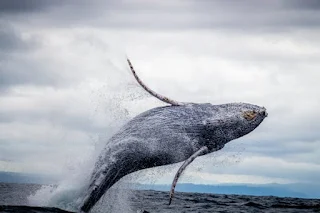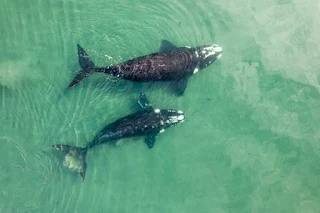Intresting facts about Blue Whales
Blue whales
are the largest animals ever known to have lived on Earth. These magnificent creatures inhabit the world's oceans, and their sheer size and the depth of their environmental impact make them a fascinating subject of study. In this essay, we will delve into various aspects of blue whales, including their biology, behavior, habitat, threats they face, and conservation efforts aimed at preserving this iconic species.
Physical Characteristics
Blue whales are truly colossal. They can grow up to 100 feet (30 meters) in length and weigh as much as 200 tons (181 metric tonnes). The largest recorded blue whale was a female, measured at 109 feet (33 meters). Despite their massive size, blue whales have streamlined bodies designed for efficient swimming. They are characterized by a blue-grey coloration, with lighter spots giving them a mottled appearance.
Their heads are flat and U-shaped, and they possess a series of 55 to 88 ventral pleats running from their lower jaw to their navel, which expand when feeding. Blue whales have small dorsal fins located near the tail, and their flippers are long and slender, measuring up to 13 feet (4 meters) in length. The tail flukes, which can span 25 feet (7.6 meters), are triangular and used for propulsion.
Feeding and Diet
Blue whales are filter feeders, and their diet consists almost exclusively of small shrimp-like animals called krill. During feeding season, a blue whale can consume up to 4 tons (3.6 metric tonnes) of krill per day. They feed by lunging at schools of krill with their mouths open, engulfing large volumes of water and prey. They then close their mouths and use their tongue to push the water out through their baleen plates—comb-like structures made of keratin—trapping the krill inside.
Reproduction and Lifespan
Blue whales reach sexual maturity at around 10 years of age. The gestation period for a blue whale is approximately 10-12 months, after which a single calf is born. Calves are about 23 feet (7 meters) long at birth and weigh around 5,000-6,000 pounds (2,268-2,722 kilograms). They are nursed for about six to seven months, during which they consume 100-150 gallons (379-568 liters) of milk per day, gaining up to 200 pounds (90 kilograms) each day.
Blue whales are believed to have lifespans ranging from 70 to 90 years, although some individuals may live over 100 years. Aging blue whales is challenging, but scientists use earplugs, which have annual growth layers, to estimate their age
.
Communication
Blue whales are known for their deep, resonant calls, which are among the loudest sounds produced by any animal. These vocalizations can travel hundreds of miles underwater and are used for communication and possibly navigation. The calls consist of long, low-frequency moans, pulses, and groans, with frequencies ranging from 10 to 40 Hz. These vocalizations are crucial for maintaining contact between individuals, especially during feeding and mating seasons.
Migration
Blue whales are highly migratory, traveling thousands of miles between feeding and breeding grounds. They spend the summer months in high-latitude, nutrient-rich waters where krill are abundant. During the winter, they migrate to warmer, lower-latitude waters to breed and give birth. The exact migration routes and destinations can vary among populations, and some blue whales may exhibit different migration patterns.
Social Structure
Blue whales are generally solitary animals, though they are occasionally seen in pairs or small groups, particularly during feeding. The mother-calf bond is strong, and calves stay with their mothers for about a year. Despite their solitary nature, blue whales are part of larger migratory aggregations and rely on acoustic communication to interact with other whales over long distances.
Blue whales are found in all the world's oceans except the Arctic. They are present in both the Northern and Southern Hemispheres, with several distinct populations identified. The main populations include:
North Atlantic Population: Found in the North Atlantic Ocean, these whales migrate between feeding grounds in the waters around Iceland, Greenland, and the eastern coast of Canada, and breeding grounds in the Caribbean Sea.
North Pacific Population: Inhabiting the North Pacific Ocean, these whales feed in the waters off the coasts of Alaska, California, and the Aleutian Islands, migrating to breeding grounds off Mexico and Central America.
Southern Ocean Population: The largest population, found in the Southern Ocean around Antarctica. These whales migrate between the icy feeding grounds and the warmer waters of the Indian, South Pacific, and South Atlantic Oceans for breeding.
Indian Ocean Population: This population is less well understood, but blue whales are known to inhabit the Indian Ocean, with feeding grounds near Sri Lanka and the Arabian Sea, and breeding grounds in the tropical waters of the Indian Ocean.
Blue whales rely on specific habitats for feeding and breeding, making them vulnerable to changes in their environment. Feeding grounds are typically characterized by high concentrations of krill, which are influenced by oceanographic conditions such as upwelling and sea ice cover. Breeding grounds are usually in warmer waters, which provide a suitable environment for calving and nursing.
Historical Whaling
The most significant threat to blue whales in the past was commercial whaling. From the early 20th century until the 1960s, blue whales were heavily hunted for their blubber, meat, and baleen. It is estimated that nearly 360,000 blue whales were killed during this period, leading to a dramatic decline in their population. The International Whaling Commission (IWC) banned commercial whaling of blue whales in 1966, but the species has been slow to recover due to their low reproductive rate and long lifespan.
Ship Strikes
One of the major threats to blue whales today is collisions with large vessels. As blue whales often migrate along shipping routes, they are at risk of being struck by container ships, tankers, and other large vessels. These collisions can result in serious injury or death. Efforts to reduce ship strikes include implementing speed restrictions and altering shipping lanes in key whale habitats.
Blue whales can become entangled in fishing gear, such as nets and lines, which can cause injury, impede their ability to feed, and sometimes lead to drowning. Entanglement is a significant threat, particularly in areas with heavy fishing activity. Fishing gear modifications, such as using whale-safe ropes and gear, can help reduce the risk of entanglement.
Climate Change
Climate change poses a long-term threat to blue whales by affecting their habitat and food sources. Changes in sea temperature, ice cover, and ocean currents can impact krill populations, which are the primary food source for blue whales. Additionally, ocean acidification, a result of increased carbon dioxide absorption by seawater, can affect the entire marine food web.
Pollution
Pollution, including chemical contaminants, plastic debris, and noise pollution, poses significant threats to blue whales. Chemical pollutants, such as heavy metals and persistent organic pollutants (POPs), can accumulate in the whales' bodies, leading to health issues. Plastic debris can be ingested accidentally, causing internal injuries or death. Noise pollution from ships, oil and gas exploration, and other human activities can interfere with blue whales' communication, navigation, and feeding.








Post a Comment